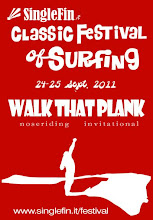 |
| the right hull make this a dream ride |
THE PLANING
The major difference between a planning hull and a displacement hull is the way in wich the surfboard travels throught the water. A displacement hull has a belly, or convex bottom countour and planning surface. This design does not ride high on the water like a planing hull, instead plowing through and parting the water. At high speeds a displacement hull´s tail will sink down the water as the surfboard moves forward. A planing hull, on the other hand, will have a flat or concave bottom countour and plane up on top of the water. The board will almost skim across the water´s surface.
THE RIDE
A displacement hull gives the surfer a very different feeling compared to what most modern surfboards are accustomed. It is a feeling of close interaction and involvement with the wave. The faster you go, the more the surfboard actually sucks into the water, it holds you for control, but the downside is the speed limit. If you take a sailboat, for example, and pull it faster than the theoretical hull speed limit of that boat, it will actually submarine.The more displacement, the more in the water you are, the more control you have. The more edge you have, the more release you have, it´s a balance between the two. A real displacement hull almost requires you to surf in the middle of the board. You have to surf of the front foot. Normally you can lean back on the tail. On a displacement hull, you step onto your front foot, bury the rail and let it go. Most people can´t make the adjustment, but once you do, it´s amazing, you really feel like you´re surfing through the water, you´re really more involved. It´s a organic feeling.
THE TURNING
A classic planing hull allows a rider to surf with a heavy back foot over the fins, using that to turn the surfboard, a displacement hull requires 100% commitment to rail turning. The shape requires that the rail be treated as a fin.
THE IDEAL CONDITIONS
A displacement hull design has the ability to provide us with a great day of surfing in smaller surf. Pushing a board through the water requires more less energy than a board planing on top of the water, making small point breaks waves very ideal.





